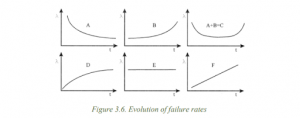Lesson 5 – The role of reliability in maintenance, indicators
In this lesson, we will explore the concept of reliability in machinery maintenance, its historical background, and the key indicators that help assess and ensure the reliability of machinery.
Understanding Reliability Theory
- Reliability theory is a discipline that deals with understanding machinery and equipment failures, predicting failures, and improving reliability during design, storage, and use.
- It emerged in the 1940s, primarily in aeronautical engineering, with a focus on safety through systematic inspection.
- Widespread use of reliability theory began in the 1970s, especially in large technological systems like nuclear power plants and complex industrial processes.
- Reliability Centered Maintenance (RCM) is an integral part of modern maintenance systems, aiming to prevent faults through analysis and prevention.
Defining Reliability
- Reliability, classically defined, refers to the equipment owner’s ability to perform tasks under specified conditions for a specific period.
- It primarily focuses on fault tolerance, particularly in products that can’t be repaired and operate until their first failure.
- Repairable machinery requires considerations beyond fault tolerance, such as durability and repairability.
Reliability in Modern Terms
- According to MSZ IEC 50(191):1992, reliability is a generic term covering serviceability and its determinants, including freedom from defects, maintainability, and provision of maintenance.
- It emphasizes solution-oriented approaches by incorporating product reliability into the quality of services provided.
- Quality of service depends on various capabilities, including availability, continuity, technical performance, and usability.
Metrics for Reliability
- Quantitative values are assigned to reliability characteristics and their time concepts using metrics.
- These metrics rely on probability and mathematical statistics due to the random nature of reliability events.
- Reliability parameters evolve throughout a machine’s life cycle, often following a characteristic curve.
Reliability of Machinery Systems
- In practice, reliability analysis extends beyond single points of failure to complex machinery comprising numerous structural units and points of failure.
- Calculating reliability parameters for machinery systems is a complex task.
- Understanding repairability and interactions between failure modes within the system is crucial.
Reliability Connection Modes
- Machinery systems may have series, parallel, or mixed connections of elements.
- Series-connected systems fail if any one element fails, and their reliability is calculated by multiplying individual reliabilities.
- Parallel-connected systems fail only if all elements fail, and their reliability is calculated using the complementary probability.
- Mixed connection systems have both series and parallel elements, and their reliability is determined by breaking them down into elementary connections.
Conclusion
- Reliability theory is integral to modern machinery maintenance, offering insights into predicting and preventing failures.
- Understanding reliability indicators and connection modes helps ensure optimal machinery performance.
- Reliability is essential in various sectors, especially in complex technological systems where failures can have severe consequences.

Read the textbook from the 29th page. You can find the textbooks’s content on this link.